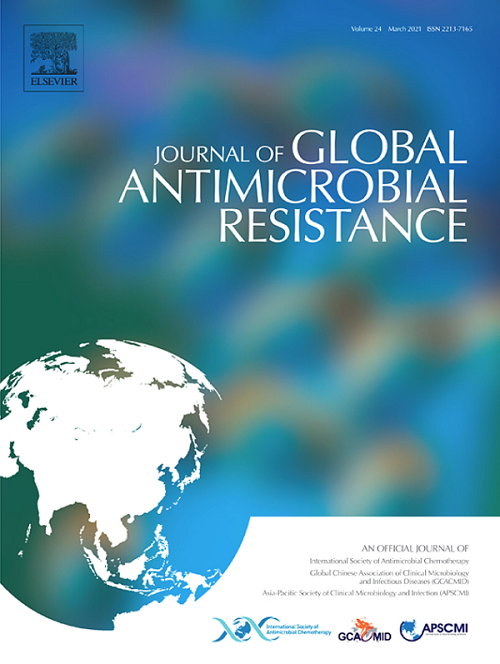阿根廷临床病例分离的IncN2和IncC2质粒上携带的blaoxa -48样新等位变异blaOXA-567的体内出现。
IF 3.7
3区 医学
Q2 INFECTIOUS DISEASES
引用次数: 0
摘要
背景:oxa -48样酶是D类β-内酰胺酶的成员,主要在肠杆菌中检测到,具有水解碳青霉烯类的能力。等位变异blaOXA-163对碳青霉烯具有较低的水解活性,于2011年在阿根廷被发现并成功传播,这为新的地方变异提供了散发性来源。目的:研究分离自2例儿科患者的大肠埃希菌M17224和肺炎克雷伯菌M21014中携带的两种新型OXA酶blaOXA-438和blaOXA-567的表型特征和传播策略。方法:采用mic法测定临床分离株、转缀合物和转化细胞的表型。通过双亲本偶联、PCR、Sanger和全基因组测序来确定质粒的完整遗传特征。结果:两株菌株均对碳青霉烯类耐药,对头孢曲松敏感。blaOXA-438位于69 Kb的IncN2质粒上,blaOXA-567位于175 Kb的IncC2质粒上,均可通过双亲本偶联转移。blaOXA基因的密切遗传环境表明它们有一个共同的起源,可能涉及移动遗传元件。最后,M21014的临床病例显示,患者既往感染过两种具有遗传相关性的肺炎克雷伯菌ST6838,其携带blaOXA-163的IncC2质粒大小和遗传特征与M21014相同,为患者内出现blaOXA-567提供了强有力的证据。结论:本研究强调了持续监测和整体研究的必要性,以了解OXA酶的出现、生化和传播能力,并以阻止其传播为总体目标。本文章由计算机程序翻译,如有差异,请以英文原文为准。

Novel allelic variants of blaOXA-48-like carried on IncN2 and IncC2 plasmids isolated from clinical cases in Argentina: In vivo emergence of blaOXA-567
Objective
The OXA-48-like enzymes have the capacity to hydrolyse carbapenems and are members of class D β-lactamases that are primarily detected in Enterobacterales. The allelic variant blaOXA-163, which has low hydrolytic activity towards carbapenems, was detected in Argentina in 2011 and has spread successfully since then, giving sporadic origin to novel local variants. The aim of this study was to analyse the phenotypic profile and dissemination strategies of two novel OXA enzymes, blaOXA-438 and blaOXA-567, located in Escherichia coli M17224 and Klebsiella pneumoniae M21014, respectively, isolated from two paediatric patients.
Methods
Minimum inhibitory concentration measurements were performed to determine the phenotypic profile of the clinical isolates, transconjugants and transformant cells. Biparental conjugation, PCR, Sanger and whole-genome sequencing were performed to determine the complete genetic characteristics of the plasmids.
Results
Both isolates were found to be resistant to carbapenems and susceptible to ceftriaxone. blaOXA-438 was located on a 69-kb IncN2 plasmid, while blaOXA-567 was found on a 175-Kb IncC2 plasmid, both transferable by biparental conjugation. The close genetic environment of the blaOXA genes suggests a common origin likely involving mobile genetic elements. Finally, the clinical case of M21014 revealed that the patient had previous infections with two genetically related K. pneumoniae ST6838 that carried blaOXA-163 on an IncC2 plasmid with equal size and genetic hallmarks to that of M21014, providing strong evidence for the intra-patient emergence of blaOXA-567.
Conclusions
This research underscores the need for ongoing surveillance and integral studies to understand the emergence, biochemistry and dissemination capacity of OXA enzymes with the overarching aim to halt their spread.
求助全文
通过发布文献求助,成功后即可免费获取论文全文。
去求助
来源期刊

Journal of global antimicrobial resistance
INFECTIOUS DISEASES-PHARMACOLOGY & PHARMACY
CiteScore
8.70
自引率
2.20%
发文量
285
审稿时长
34 weeks
期刊介绍:
The Journal of Global Antimicrobial Resistance (JGAR) is a quarterly online journal run by an international Editorial Board that focuses on the global spread of antibiotic-resistant microbes.
JGAR is a dedicated journal for all professionals working in research, health care, the environment and animal infection control, aiming to track the resistance threat worldwide and provides a single voice devoted to antimicrobial resistance (AMR).
Featuring peer-reviewed and up to date research articles, reviews, short notes and hot topics JGAR covers the key topics related to antibacterial, antiviral, antifungal and antiparasitic resistance.
 求助内容:
求助内容: 应助结果提醒方式:
应助结果提醒方式:


